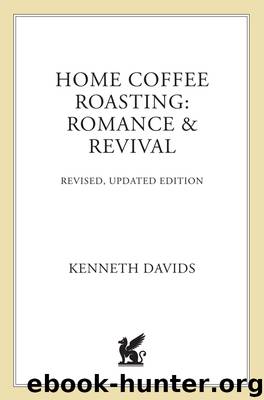Home Coffee Roasting: Romance & Revival by Kenneth Davids

Author:Kenneth Davids
Language: eng
Format: epub
Publisher: St. Martin’s Griffin
Chapter 2
FROM SPOON TO FLUID BEDS
Roasting History
The discovery that the seeds of the coffee fruit tasted good when roasted was undoubtedly the key moment in coffee history. It marked the beginning of the transformation of coffee from an obscure medicinal herb known only in the horn of Africa and southern Arabia to the most popular beverage in the world, a beverage so widely drunk that today its trade generates more money than any other commodity except oil.
A skeptic might counter that it is caffeine, not flavor (or the roasting necessary to develop that flavor), that made coffee into one of the world’s most important commodities. This argument is difficult to sustain, however. Tea, yerba maté, cocoa, coca, and other less famous plants also contain substances that wake us up and make us feel good. Yet none has achieved quite the same universal success as coffee.
Furthermore coffee—coffee without the caffeine—figures as an important flavoring in countless candies, cakes, and confections. And people sensitive to caffeine happily choose to drink decaffeinated coffee in preference to other caffeine-free beverages.
So clearly the aromatics of roasted coffee have a great deal to do with its triumph. On the other hand, there is evidence that the taste of coffee takes some getting used to. Children do not spontaneously like coffee, for example. And from coffee’s first appearances in human culture to the present, people have tended to add things to it. The first recorded coffee drinkers enhanced the beverage with cardamom and other spices, a tendency that continues today with flavored coffees and espresso drinks augmented with syrups, garnishes, and milk.
More than likely it is both the aromatic characteristics of roasted coffee and its stimulant properties that hooked humanity. At some point people began to associate the stimulating effect of coffee with the dark resonance of its taste, and combined those associations with the myriad social satisfactions that began to cluster around the beverage; coming to consciousness in the morning, hospitality, conversation, the reveries of cafés. Thus the entire package—stimulation, taste, and social ritual—came together to mean coffee in all of its complexity and richness.
Coffee-Leaf Tea and Coffee-Fruit Frappés
We can only speculate how coffee was consumed before the advent of roasting sometime in the sixteenth century. However, the practices of some African societies in the regions where the coffee tree grows wild give us clues.
Ethiopian tribal peoples make tea from the leaves of the coffee tree, for example. Other recorded customs include chewing the dried fruit, pressing it into cakes, infusing it, mashing the ripe coffee fruit into a drink, and eating the crushed seeds imbedded in animal fat.
It is difficult to believe that coffee would have become the beverage of choice of most of the world if the only way to experience it was by infusing its leaves; putting its rather meager, thin-pulped fruit in a blender; or chewing on its raw seeds. Furthermore, there is at least some evidence that coffee’s accelerated success over the past two centuries may be in part the result
Download
This site does not store any files on its server. We only index and link to content provided by other sites. Please contact the content providers to delete copyright contents if any and email us, we'll remove relevant links or contents immediately.
Whiskies (Collins Gem) by dominic roskrow(42213)
101 Whiskies to Try Before You Die by Ian Buxton(42179)
Whiskies Galore by Ian Buxton(40331)
Craft Beer for the Homebrewer by Michael Agnew(17446)
Right Here, Right Now by Georgia Beers(3497)
Not a Diet Book by James Smith(2726)
Water by Ian Miller(2582)
The Coffee Dictionary by Maxwell Colonna-Dashwood(2531)
Kitchen confidential by Anthony Bourdain(2306)
Coffee for One by KJ Fallon(2007)
Smuggler's Cove: Exotic Cocktails, Rum, and the Cult of Tiki by Martin Cate & Rebecca Cate(1979)
Beer is proof God loves us by Charles W. Bamforth(1920)
Superfood Smoothie Bowls: Delicious, Satisfying, Protein-Packed Blends that Boost Energy and Burn Fat by Chace Daniella(1902)
Talking as Fast as I Can by Lauren Graham(1832)
Bourbon: A Savor the South Cookbook by Kathleen Purvis(1791)
A Short History of Drunkenness by Forsyth Mark(1720)
Eat With Intention by Cassandra Bodzak(1687)
Cocktails for the Holidays by Editors of Imbibe magazine(1626)
Colombia Travel Guide by Lonely Planet(1609)
